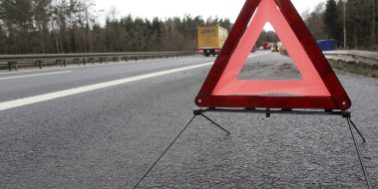First trialled in 2006 by the Highways Agency, smart motorways have become more common in the UK, there are several differences between them and the other roads that make up England’s motorway network. If you suffer a break down on a smart motorway, it is important to remember that the hard shoulder is replaced by another left-hand lane to improve traffic flow in busy periods.There are numerous things you should bear in mind if you are travelling on a smart motorway in the new year. Allow us to talk you through the process so that you are well prepared should you suffer any issues with your vehicle.
Emergency refuge areas (ERA)
If you break down on a smart motorway, dynamic hard shoulders mean that they can be used as a live lane at any point congestion begins to build up. This means that there will be four lanes running, so there are emergency refuge areas every 1.5 miles suitable for you to pull into should you suffer a breakdown. These are marked by large blue signs and should only be used in an emergency situation. Once you pull into here, you should turn on your hazard warning lights, exit the vehicle on the left side and stand behind the safety barrier whilst contacting your breakdown cover provider.
What to do if you don’t make it to an ERA
The problem with these ERAs is clear – what happens if your car breaks down before you can reach the next one? The safest approach is to move across to the furthest left-hand lanes and on to the verge if possible, switching on your hazard lights. Highways England monitors these smart motorways through regional control centres and, once they are aware of the stranded vehicle, they will signify that they are closing the lane by displaying a red X above it. Traffic officers or other emergency services will then be sent to deal with the situation. Variable speed limits are also in place for drivers, so that they can be warned to slow down if there are any oncoming hazards.
Ensure you’re prepared for a breakdown this winter
You will want to ensure you have these essentials in your car should you suffer a breakdown over the colder months:
Ice scraper
If you’re setting off this winter, by law you must ensure your front and rear windscreen are clear before driving, so as to not endanger yourself or any other drivers on the road.
Torch
If your vehicle is stranded on a poorly lit road, a torch that is fully charged is essential in finding help or alerting passers-by that you require assistance.
Warning triangle
Despite not being a legal requirement in the UK, many countries make it essential for you to carry one of these in order to warn other drivers of the stranded vehicle.
Phone and in-car charger
If your vehicle breaks down, it is essential you have access to a phone so that you can contact your breakdown cover provider. Keeping a device and its charger in your car can give you peace of mind.
Jump start cables
The cold weather can cause your car’s battery to go flat a lot faster than any other time of year, so you will want to ensure you have these cables so another motorist can help get you on the move again.
Taking these steps can ensure you are better prepared for any eventuality this Christmas, and if you are driving on a smart motorway you will want to be prepared to deal with a breakdown, whether you can make it to an emergency refuge area or not. Following these instructions will allow you to safely pull over without putting yourself and others on the road at risk and allow the relevant authorities to provide their assistance. If you would like to ensure your vehicle is fully prepared for winter, contact our team at Double Dee Autos and book a service so that we can carry out all necessary checks, or any repairs that are necessary. Give us a call on 020 8460 3040 or email ben@ddautos.co.uk to get booked in as soon as possible.

